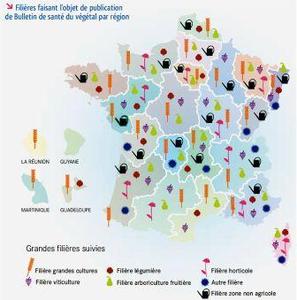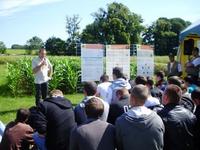
Country profile: France
In the third of our country profiles we examine France, where the ambitious challenge has been set of halving pesticide use nationally over the course of 10 years. In this article, Philippe Delval, an ENDURE participant working at ACTA, the ‘Network for Innovative Research in Agriculture’, and Marco Barzman, ENDURE’s Scientific Officer, examine Ecophyto 2018, France’s National Action Plan.
Two major initiatives launched in 2007 have been key to shaping Ecophyto 2018: the Grenelle de l’Environnement, a major stakeholder consultation on a broad range of environmental issues, and Ecophyto R&D, a study on low-input agricultural methods which explored what is feasible and the means and resources required to reach the goal.
The resulting Ecophyto 2018 programme recognises that reaching a 50% reduction will require more than merely enhancing current institutions and resources or tweaking existing cropping systems. Significant efforts have therefore been invested to mobilise a large and more diverse group of actors, to provide knowledge support to advisers and farmers, and to promote changes at the cropping system level including, but also going beyond, a rationalised use of pesticides or reliance on non-chemical products. The programme is funded by a fraction of the national non-point source pollution tax with co-funding from the partners involved, and by making judicious use of appropriate existing structures. In 2012, dedicated funding is €41 million not including significant co-funding and in-kind contributions from the many participating institutions.
Systems approach
One conclusion from Ecophyto R&D was that an overall reduction of 30% in pesticide use could be achieved without a major upheaval to existing cropping systems and profit margins. In some cases, however, there would be a slight reduction in production. In field crops, for example, which occupy the largest share of French agricultural land and account for the largest share of pesticide use, there would be a 6% reduction in production. To go beyond this level and still maintain high levels of productivity, system-level changes known as ‘breaks’ would be required. Today, the concept of breaks at the cropping system level is embedded in learning manuals and information sheets for farmers and advisers. They emphasise the manipulation of agronomic practices as a lever for crop protection.
The first of the manuals, ‘The STEPHY guide on strategies for crop protection less reliant on pesticides’, focuses on arable crops. It was produced via a collaborative effort involving INRA researchers, extension staff from Agricultural Chambers and National Technical Institutes, and government employees from the French Agriculture, Environment, Research and Education Ministries. It is based on a learning process which includes:
- An assessment of existing cropping systems.
- The joint co-design of alternative low-pesticide input cropping systems by an adviser and farmer.
- An evaluation of alternative low-pesticide input cropping systems according to multiple criteria, including the level of pesticide use.
- A collective discussion of results.
It was tested by groups of farmers and advisers during training sessions in 2009 and is now available online in French. An English version of the STEPHY guide will shortly be available on the ENDURE website and via the ENDURE Information Centre. Similar manuals for viticulture, fruit orchards and vegetables are also being produced.
Additionally, a series of information sheets on specific practices to achieve specific environmental goals are being developed. This resource, named ‘Agro-PEPS’, is ready to produce information covering 150 techniques dealing with 51 specific environmental objectives. Agro-PEPS information sheets are designed to evolve via a collaborative online application for the sharing of technical information and experiences.
This autumn, a new website called EcophytoPIC (PIC equals IPM in French) will be available to make resources such as these widely accessible to farmers, advisers and trainers. The website is designed as a central reference point, acting as a gateway to all sources of information relating to Ecophyto 2018.
To develop innovative crop protection solutions based on agronomy, researchers at INRA, Arvalis and Cetiom, are conducting experiments at the cropping systems level. The parameters involved in these longer term experiments in arable crops (wheat, oilseed rape, maize, barley, pea, etc.) include choice of crop sequence in the rotation, insertion of spring crops within cropping systems based on winter crops, relay crops, sowing date and density, mixed cultivar stands, mechanical weeding and inter-row spacing, and combinations of single control methods.
Demonstration farm network
Through Ecophyto 2018 a large effort is being invested in ensuring that information and knowledge to support change is available throughout the country across all major commodities. The programme recognises that there are many farmers who have already adopted interesting and innovative practices or who are willing to experiment with low-pesticide input techniques and systems.
Based on such farmers, a network of reference cropping systems designed to generate information and become the subject of scrutiny and discussions among the wider agricultural community has been established. Currently, 30 different cropping system categories have been identified and characterised.
By the end of 2012, a network involving 2,000 farmers will have been created, with each farmer set specific tasks such as outlining and introducing their project for a low-pesticide input cropping system, including identifying the difficulties. Farmers will be expected to participate in the production of references for low-pesticide input cropping systems and to make available data at the farm, cropping system and field scale to the ‘network engineer’ working with the farmer. They will also be expected to contribute to the communication and demonstration of these systems.
Each farm in the network is working with one of 184 network engineers, who are in turn coordinated by 12 regional agents. Each engineer has been assigned a clear set of tasks such as supporting groups of 12 farmers in achieving their objectives of lowering pesticide use, analysing brakes and levers, collecting and validating data and contributing to the production of references and disseminating them, including local communication campaigns and demonstrations.
Monitoring for within-season management
One of the principles of classical IPM is that a pest monitoring system is required, making it possible to link decisions on control actions to actual observations and thus reduce pesticide use. In this regard, the Ecophyto 2018 programme has established an ambitious pest monitoring network for within-season pest management.
An epidemiological surveillance network has been set up. It involves more than 2,700 observers working in the field, with more than 8,000 plots under regular scrutiny. To date, more than 3,000 ‘Bulletin de Santé du Végétal ’ have been published, providing a weekly update on pest pressure. The bulletins, available online, explicitly avoid prescribing any control measures or mentioning pesticides. Such caution is designed to avoid automatic ‘knee-jerk’ decisions and promote reflection based on a general picture.
In 2012, the network is being extended to cover non-intentional effects of agricultural practices. Specifically, the emergence of pesticide resistance among certain pests and effects on biodiversity will be gradually included in monitoring protocols. Introducing observations of such non-intentional effects in monitoring systems adds an innovative dimension to systems traditionally used to make treatment decisions based on pest risks and not taking into account other types of risks.
Europe – ENDURE
There is a clear acknowledgement in France that sharing knowledge and experience on IPM and low-pesticide input cropping systems across Europe is highly valuable. In this regard, the Expert Committee responsible for follow-up of the implementation of the Ecophyto 2018 plan has included ENDURE representation in its membership. Also, the French Ministry of Agriculture successfully proposed in 2011 the creation of a Collaborative Working Group on IPM under the umbrella of the Standing Committee on Agricultural Research.
ENDURE has contributed to this group, which is mapping out the research and extension needs required for the successful development and use of IPM by all professional pesticide users, as required by the Framework Directive on the Sustainable Use of Pesticides (2009/128/EC). The group also serves as a forum to share national experiences. For instance, the French national monitoring network was presented there. France is also active among a group of Member States who regularly keep each other updated on the state of the art of their National Action Plans.
For more information:
To read previous country profiles:
To read about an EU Expert Meeting which took place in Berlin in June 2012 and access presentations on National Action Plans from 12 countries:
Last update: 24/05/2023 - ENDURE © 2009 - Contact ENDURE - Disclaimer


